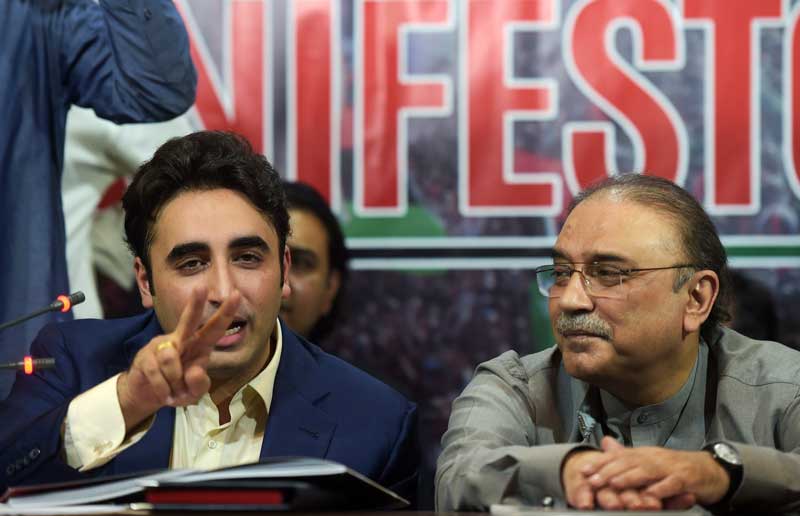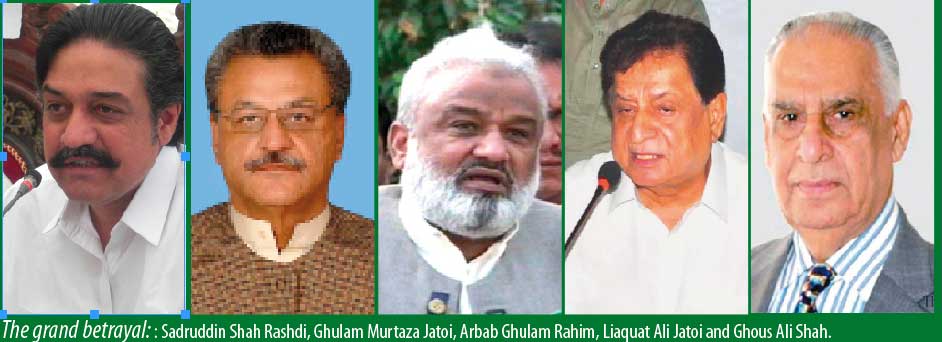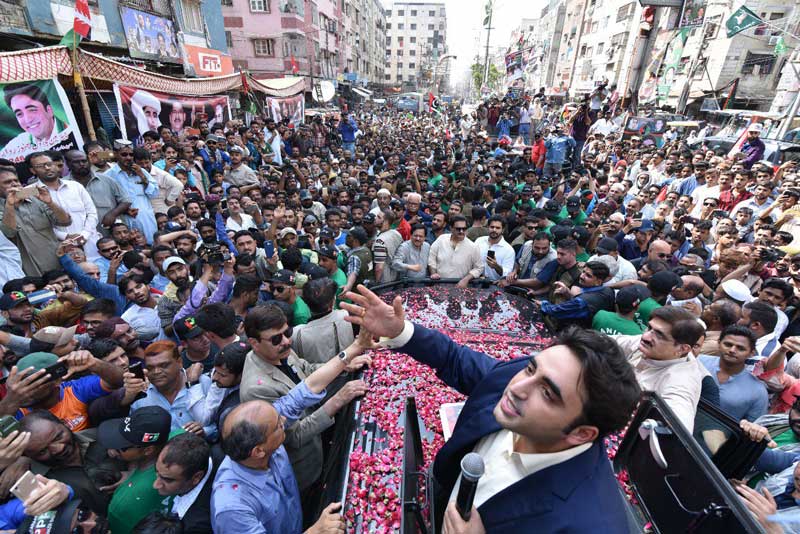The Bilawal Factor
By Shahzeb Jillani | Newsbeat National | Published 7 years ago

It was generally believed that the PPP would be punished for its perceived disastrous performance in Sindh. Instead, the party picked up more seats and secured an unprecedented third term. How did that happen? How did most political pundits get it spectacularly wrong once again?
Disdain for the PPP’s governance among the urban middle class has not been without reasons. The government was tainted by frequent corruption scandals and poor service delivery. It demonstrated a high degree of incompetence and lack of imagination. But in the end, to voters outside of Karachi, none of it seemed to matter. The anti-PPP alliance of parties collectively referred to as the Grand Democratic Alliance (GDA), failed to make a dent in the PPP’s vote bank. Most of its central leaders lost miserably.
In large part, it was because of the voters’ traditional emotional attachment to the Bhuttos. The party understood this well and capitalised on the ‘Bhutto card’ in their campaign, led by its 29-year-old chairman, Bilawal Bhutto Zardari. His father and co-chairman of the party, Asif Ali Zardari, and aunt, Faryal Talpur, decided to stay out of the campaign trail. It was seen as a tacit admission by the family that voters may not respond well to the duo, widely accused by detractors of promoting a culture of corruption during the last 10 years.
Bilawal Bhutto Zardari, therefore, had to be the face of the campaign. His road show got off to a bumpy start in Lyari, the PPP’s traditional stronghold in Karachi, where opponents pelted stones and clashed with his supporters. But instead of discouraging him, the incident only helped fire him up.
As Bilawal’s entourage made its way through various districts of Sindh, addressing charged crowds in towns and cities, he demonstrated a rare stamina and charm. It was the spark the party desperately needed to reinvigorate its ambivalent support base. If the idea was to create an impression that Bilawal — and not Mr Zardari and Ms Talpur — was increasingly taking charge of the party, it had the desired effect.
By the time Bilawal’s campaign reached Lahore, the youngest head of a political party displayed a greater degree of maturity and sensibility than his much older counterparts in the PTI and the PML-N. Criticising Imran Khan in particular, Bilawal refused to indulge in, what he called “the politics of abusive language.”
While Imran Khan championed his “anti-corruption” cause and Shehbaz Sharif played up his “development” record in Punjab, Bilawal articulated his party’s populist, progressive message. As the campaign came to a close, Bilawal appeared to resonate well with crowds in Khyber Pakhtunkhwa (KP) and Punjab. While it was too late for an electoral impact, it showed the future potential of Bilawal emerging as a leader in his own right.
But observers believe that the biggest factor which allowed the party to secure a third term was the absence of a determined effort by the establishment to defeat the PPP. “That is all we ever sought, an election in which the army and the ISI stay neutral,” says a PPP leader.
Insiders say that Asif Ali Zardari’s decision last year, to publicly align himself with the establishment to isolate the former prime minister, Nawaz Sharif, was a vital part of that strategy. At the time, the PPP leadership was criticised for siding with anti-democratic forces to undermine the civilian leadership.
In January, Zardari went to the extent of sharing a platform with the Pakistan Awami Tehreek (PAT) cleric, Tahirul Qadri, at a failed anti-Sharif rally in Lahore. Zardari was accused of using his financial power to help topple the PML-N led government in Balochistan and ‘buying’ votes in the Senate election. The PPP demoted Raza Rabbani, a leading critic of the army’s interference in politics, from his role as the Senate Chairman. In March, the party helped instal a political novice, Sadiq Sanjrani (believed to be the army’s preferred candidate), as the new Chairman, while securing the deputy chairman slot for its nominee.

All along, party leaders were tasked to singularly target Nawaz Sharif in speeches and on the media, in an attempt to neutralise the establishment. In the months preceding the polls, the strategy appeared to pay off in easing the pressure of ongoing corruption cases against the party leaders. A noticeable shift in the focus of the National Accountability Bureau (NAB), from the PPP in Sindh, to the PML-N in Punjab, roused allegations that the body was being used as a black-mailing tool by the deep state. Still, with the party firmly falling in line with the establishment, Zardari managed to gain political space in Sindh.
For its part, the GDA struggled to present itself as the best available alternative to Zardari’s PPP. Led by Pir Pagara’s Pakistan Muslim League-Functional (PML-F), the alliance was seen as a coming together of tried and tested politicians, whose previous stints in power did little to inspire voters. Young, urban and educated voters, who may have been drawn to the PTI, were disappointed by its seat adjustments with the GDA’s feudal politicians. Efforts at the top to bring all anti-PPP voters together often did not materialise on the ground.
As a result, GDA politicians lost a number of seats in their strongholds. Former federal minister, Sadruddin Shah Rashdi of the PML-F, lost in Khairpur, while his candidates faced defeat in Sanghar. Another former federal minister and a feudal heavy weight, Ghulam Murtaza Jatoi, was defeated in his home constituency of Naushero Feroze. Former chief ministers — Arbab Ghulam Rahim, Liaquat Ali Jatoi and Ghous Ali Shah — all lost their seats in Thar, Dadu and Khairpur, respectively.
“The GDA was betrayed by its backers,” maintained Ayaz Latif Palijo, the fiery secretary general of the alliance, in the immediate aftermath of his own defeat from a provincial assembly seat of Qasimabad, Hyderabad. The alliance later went on to reject the polls and demanded a fresh election in Sindh.
For the PPP, a major setback was Bilawal’s defeat in Lyari, where he lost to a PTI candidate and came a distant third, behind a new sectarian party, Tehreek-e-Labaik Pakistan (TLP). Similarly, the party lost the provincial assembly seat from Larkana city to GDA candidate, Moazzam Abbasi.
Overall though, the PPP’s deeply entrenched patronage politics coupled with a fair dose of emotional appeal of the ‘Bhutto factor,’ triumphed in Sindh. The GDA failed to capitalise on the anti-incumbency factor. In the absence of a viable option, many disgruntled PPP supporters opted for the winning side.
So, will the next five years lead to more of the same in Sindh? Despite its stunning victory, Bilawal Bhutto Zardari seems to recognise that the party will have to up its game. Addressing his newly-elected parliamentarians days after the polls, he told them that the new government would have to focus on service delivery. “Good governance and better performance will have to be the hallmark of the new provincial government,” he said.
But such a fresh start will require a break from the old, dysfunctional ways of running a government. Many feel that unless Bilawal takes greater responsibility for delivering a more competent and cleaner government, it may be easier said than done.
Routed in Lyari
The Pakistan Peoples Party’s (PPP) choice of candidates for the provincial constituencies from Lyari, the party’s traditional stronghold – Javed Nagori, PS-107, and Abdul Majeed, PS-108 – did not go down well with the party’s long-time supporters in the area.
The residents of Kalri, a Lyari locality, are not familiar with Abdul Majeed’s name, the reason being that the local residents know him by his moniker —Abdul Satta — and for his involvement in the gambling racket. He has recently grown a fist-long beard, perhaps to give the impression that he has turned over a new leaf. A familiar pattern for people with a shady past.
The situation in PS-107 was not very different. Here, the party ticket was given to Javed Nagori, a former MPA from the same constituency. The locals were quite furious at the PPP leadership for awarding the ticket to Nagori for the second time, owing to his poor performance in the last term. They complained that he never visited his constituents, nor did he solve their problems. Also, he is said to have links with the much-despised People’s Aman Committee (PAC). They expressed their displeasure by staging a protest. They did not let the rally led by party chairman Bilawal Bhutto Zardari — contesting the NA-246 seat — enter the Katchi localities in Lyari. The protest turned violent when stones were pelted at vehicles in the rally, breaking several windows. The incident was termed a conspiracy against the PPP by its officials, and the police lodged an FIR against the protesters.
During Z.A. Bhutto’s time, Lyari was a stronghold of the PPP. And Benazir held her wedding reception in Lyari which was attended by the entire local community. But over the years, the PPP started to take their constituents in the area for granted. And this time round, the party leadership did not bother doing its homework when selecting candidates. They failed to realise that Lyari had changed drastically in recent years.
In the 2013 elections, the PPP was forced to pick candidates backed by the PAC and the polling process was manipulated by PAC militants. Despite this, the the Pakistan Tehreek-e-Insaf (PTI) candidate, Subhan Ali Sahil, bagged 26,000 votes in the contest on the NA 248 seat (now NA-246), against the PAC-backed candidate and the PPP ticket-holder, Shah Jahan Baloch. Maulana Sherin Muhammad, the candidate of the Jamiat Ulema-e-Islam-Fazal (JUI-F) got 9,000 votes.
Baloch won the contest easily by securing 84,000 votes, but the PTI candidate’s numbers were an eye-opener. Sahil was contesting from two NA constituencies in 2013 — NA-239 and NA-248. However, he focused his campaign only on NA-239 (Baldia Town and Keamari Town) because he felt he had a bigger chance of a win there. He didn’t even bother to campaign for NA-248 and yet he polled 26,000 votes from Lyari. The PAC chief, Uzair Baloch, was quoted as saying, “Thousands of ballot papers with stamps of the PTI symbol, the cricket bat, surprised us.”
But these numbers didn’t ring any alarm bells in PPP quarters. So confident were they of a victory in Lyari, that they never dreamt they would be, or could be, bested by another, and that too by the candidate of a party with such a poor organisational structure in the city. The PTI leadership showed little interest in Karachi’s affairs. As a former district west PTI official said, “Imran Khan gets interested in Karachi only at election time.”
This time round, although the PTI had put in a lot of effort and emerged as a strong contender, no one had expected this outcome. Most of the political commentators had predicted that the split in the MQM would result in a divided mandate between the MQM-P and the PSP, with the Muttahida Majlis-e-Amal (MMA) and the Tehreek-e-Labbaik Pakistan (TLP) getting some benefit in a few constituencies. The maximum they thought the PTI could achieve would be a doubling of the number of the seats they got in the 2013 general elections (one NA and two PS seats from Karachi).
However, thanks to an improved law and order situation in the city and a weakening of the major stakeholder, the MQM, there was a level playing field for all the parties. The PPP has been in power in Sindh for two consecutive terms, while the MQM has had the charge of the local government, but their performance in dealing with major issues has been far from satisfactory.
Somewhat belatedly, after the stone-pelting incident, the PPP realised that mere slogans would not woo the voters, even in their stronghold, Lyari, and so they started distributing money to open offices for the party campaign and hired people to work as polling agents on polling day. It made little difference. The party faced a shocking upset, losing all the seats from Lyari — one NA and two PA seats. Abdul Shakoor Shad, the PTI candidate, a former member of the PPP, won NA-246, garnering 52,750 votes. He defeated Bilawal, who polled 39,325 votes by 13,425 votes. Bilawal came in third, after the TLP candidate, who got 42,345 votes. The MMA candidate was in fourth place, with 33,075 votes. PS-107 was won by the TLP’s Zahid Soomro, and Syed Abdul Rashid won the only seat for the MMA in the Sindh Assembly — PS-108.
Unfortunately, in his very first foray in electoral politics, Bilawal Bhutto Zardari crashed and burned in a constituency in which the PPP had never before lost an NA seat.



